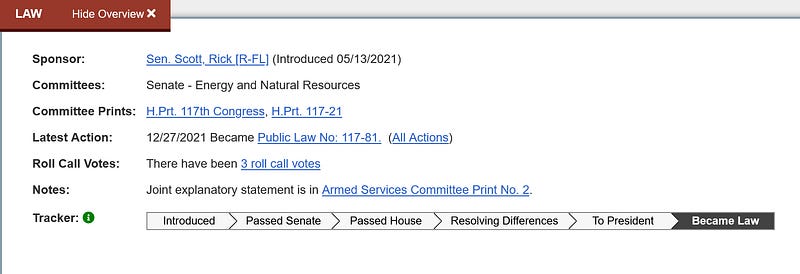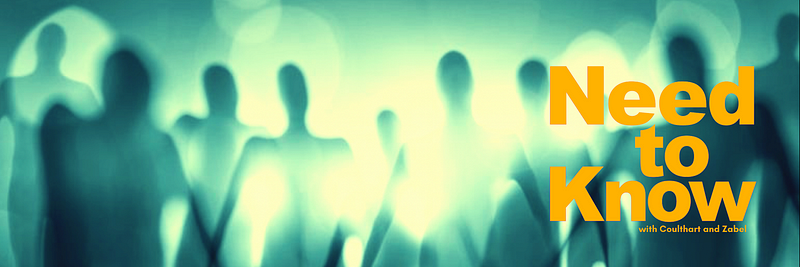UAP Reports: Legal Obligations and Ongoing Delays
Written on

The national security landscape appears to overlook legal mandates, leaving many to wonder what actions can be taken.
For those interested in Unidentified Aerial Phenomena (UAPs), the absence of a required UAP report to Congress, originally due on October 31, 2022, comes as no surprise.

On December 12, 2021, former President Donald Trump enacted the National Defense Authorization Act (NDAA) for 2022, which included stipulations for a yearly report on UAPs from the Department of Defense (DoD) and the Intelligence Community (IC). This is what was promised:
Annual Report.--
- Requirement.--Not later than October 31, 2022, and annually thereafter until October 31, 2026, the Director, in consultation with the Secretary, shall submit to the appropriate congressional committees a report on unidentified aerial phenomena.
- Elements.--Each report under paragraph (1) shall include, with respect to the year covered by the report, the following information:
- All reported unidentified aerial phenomena-related events that occurred during the one-year period.
- All reported unidentified aerial phenomena-related events that occurred during a period other than that one-year period but were not included in an earlier report.
- An analysis of data and intelligence received through each reported unidentified aerial phenomena-related event.
- An analysis of data relating to unidentified aerial phenomena collected through geospatial intelligence; signals intelligence; human intelligence; and measurement and signature intelligence.
- The number of reported incidents of unidentified aerial phenomena over restricted airspace of the United States during the one-year period.
- An analysis of such incidents identified under subparagraph (E).
- Identification of potential aerospace or other threats posed by unidentified aerial phenomena to the national security of the United States.
- An assessment of any activity regarding unidentified aerial phenomena that can be attributed to one or more adversarial foreign governments.
- Identification of any incidents or patterns regarding unidentified aerial phenomena that indicate a potential adversarial foreign government may have achieved a breakthrough aerospace capability.
- An update on the coordination by the United States with allies and partners on efforts to track, understand, and address unidentified aerial phenomena.
- An update on any efforts underway on the ability to capture or exploit discovered unidentified aerial phenomena.
- An assessment of any health-related effects for individuals that have encountered unidentified aerial phenomena.
- The number of reported incidents, and descriptions thereof, of unidentified aerial phenomena associated with military nuclear assets, including strategic nuclear weapons and nuclear-powered ships and submarines.
- In consultation with the Administrator for Nuclear Security, the number of reported incidents, and descriptions thereof, of unidentified aerial phenomena associated with facilities or assets associated with the production, transportation, or storage of nuclear weapons or components thereof.
- In consultation with the Chairman of the Nuclear Regulatory Commission, the number of reported incidents, and descriptions thereof, of unidentified aerial phenomena or drones of unknown origin associated with nuclear power generating stations, nuclear fuel storage sites, or other sites or facilities regulated by the Nuclear Regulatory Commission.
- The names of the line organizations that have been designated to perform the specific functions under subsections (c) and (d), and the specific functions for which each such line organization has been assigned primary responsibility.
- Form.--Each report submitted under paragraph (1) shall be submitted in unclassified form, but may include a classified annex.
What a letdown, right?
By signing this bill, the President made it legally obligatory for the DoD and IC to produce the UAP report for the public by the deadline. Annual reports were to continue until 2026.
However, as of now, a month has passed since the due date, and there has been no report whatsoever. The DoD has provided no explanation for its failure to comply with the law.
When inquiries were made, a spokesperson from the DoD redirected questions to the Office of the Director of National Intelligence (ODNI), which is responsible for generating the report. Yet, silence reigns on that front too.
No one from Congress has shared any insights, either.
Is the law perceived by some in the DoD as merely a suggestion?
Lack of Transparency
The American public is sidelined in the UAP dialogue.
On May 17, 2022, the first Congressional hearings on UFOs since 1969 took place in Washington, D.C. The DoD sent two senior officials: Ronald S. Moultrie, Under Secretary of Defense for Intelligence and Security, and Scott Bray, Deputy Director of Naval Intelligence.
After a brief mention of “transparency,” these officials revealed either their ignorance or their unwillingness to share information about UAPs frequently entering U.S. airspace. Their explanations, citing drones and camera artifacts, failed to convince anyone, and one example video was so unremarkable that it undermined their credibility.
Representative Mike Gallagher's questions regarding incidents over nuclear sites, such as Malmstrom Air Force Base, were met with indifference, despite ample documentation and eyewitness accounts of such alarming occurrences. It seems national security is at stake, yet they claimed ignorance.
Gallagher, who mentioned he prepared for the hearing in “five hours,” also inquired about the controversial Wilson memo, which discusses secretive corporate R&D related to recovered UFOs. Moultrie and Bray feigned ignorance here as well, indicating they were less prepared than the Congressman himself.
The lack of insight from these high-ranking officials suggests they might not want to engage with the topic of UFOs. If they are not interested, should the public be?
After all, the DoD's primary mission is to protect American citizens. They receive directives through funding acts like the NDAA. However, once classified security measures are invoked, the public is left to trust their assurances.
In the view of the DoD, the American people seem to lack the right to know what is being done (or not) to ensure their safety in relation to these enigmatic phenomena.
Tradition of Concealment
The ongoing pattern of denial and secrecy is deeply ingrained.
A recent Politico article highlights another law that several U.S. Government agencies are neglecting. The National Archives, which are attempting to recover missing presidential records from the Trump era, have been clashing with the Pentagon, the FBI, and the CIA.
In 1992, legislation was enacted to make public previously withheld files concerning the assassination of President John F. Kennedy. All such documents were to be accessible to researchers by now. Yet, despite the National Archives' persistent efforts, many records remain concealed.
As Politico notes, events from nearly a lifetime ago are still kept from public scrutiny under the guise of national security concerns. Although these agencies are aware of their obligations, they continue to press for waivers to avoid compliance.
Moreover, the CIA has a track record of destroying information rather than providing it for public accountability. The destruction of MKULTRA records (illegal human experimentation) and interrogation videos from post-9/11 detainees are just two examples of many known instances.
The unfortunate reality is that the American public is often the last to know what transpires in their name, if they ever learn anything at all.
Concealed Accountability
Security classification serves as a shield.
The ongoing delay in the UAP report likely indicates deeper issues at play. It appears there may be internal disputes within the DoD regarding disclosure.
In another overlooked Politico article, Bryan Bender reported a conversation with a Pentagon intelligence officer:
The official described a faction within military and intelligence agencies that “takes this subject very seriously” and is protective of UAP-related data.
“They fetishize their secret society,” the official remarked. “It’s akin to a Skull and Bones-type atmosphere. They take it seriously but have zero accountability. A group of us possess in-depth knowledge on this topic, much of which has not been reported to Congress due to security concerns.”
This is shocking information.
It seems there are individuals within the DoD who believe they are above the law, prioritizing their own values and judgments over the Congressional mandate to share their knowledge about UAPs with the public.
The concealment process is refined within a tightly controlled security classification framework. The power that comes with secrecy can be intoxicating. Decisions made by these hidden figures lack oversight from the Constitutionally mandated representatives of the American people, who are responsible for holding the government accountable.
Congress has made it clear that this is unacceptable and demands change. They have asked firmly yet politely, but their requests are being ignored.
The guardians of secrets appear to have gone rogue, operating independently of oversight.
Time for Action
Delays represent just one tactic in a struggle to maintain control.
Anyone following the slow trickle of UAP/UFO disclosure, initiated in 2017 by The New York Times, knows that there are significant issues to address.
Sufficient government documents have been released through Freedom of Information Act requests to demonstrate a longstanding campaign to mislead the American public about UAPs. This effort began with what is now known as the United States Air Force in 1947 and has been supported by the CIA ever since.
Those who perpetuate this attitude towards UAPs have successfully evaded accountability to the public. They denied access to Senate Majority Leader Harry Reid when he requested information. Insiders such as Christopher Mellon and Lue Elizondo have indicated that inquiries from those they choose not to include are routinely dismissed.
The narrative surrounding the Wilson memo illustrates this point. Ultimately, it revolves around the struggle for power regarding information that could impact humanity.
The assertion that revealing any information to the public would compromise national security is convenient for those wishing to keep secrets. However, senior Congress members possess the necessary security clearances. Clearly, those withholding this information are reluctant to share it, even though they are obliged to do so by their oaths.
Shortly, Congress will address a new round of demands for transparency. The legislation, designed to amend the law referenced earlier, is extensive and leaves little room for misinterpretation. Congress is dissatisfied with the lack of response they have received thus far.
So, if you pause to reflect, should you not also be concerned? The nation has recently faced the uncertainty of a rebellion instigated by a President reluctant to relinquish power — ironically, the same individual who mandated the UAP report.
What consequences will result for those who have failed to comply with the legal requirement for a UAP report that was due weeks ago?
Did civilian oversight of the military-industrial complex indeed dissipate long ago, as warned by Dwight Eisenhower?
And what can be done about it?
To dismantle these layers of secrecy, we must first identify those responsible. Even if we can pinpoint the rogue elements that have monopolized what could be humanity's most significant discovery, gaining access to the information they control may remain elusive.
At this juncture, our best hope lies in the forthcoming legislative vote. Reach out to your Representatives and Senators. Make your voice heard. Express your concerns about the absence of the UAP report, a right guaranteed to you by law.
And, if you believe it will have an impact, inquire about accountability. Do not expect an answer, as that information is likely still classified.
For ongoing insights into the UFO/UAP issue, check out Need to Know with Coulthart and Zabel.
